Bird watching is a great pastime on a cold winter day. Why not stay inside, where it’s nice and warm, and watch the birds. Enjoy hot cocoa or a cup of coffee while watching them come and go. It’s very relaxing!
What’s the best way to attract birds? They’re just like teenagers, feed them and they will come. I normally put out sunflower seeds and suet all winter long. That combination seems to draw in a wide variety of birds.
My favorite suet feeder is one that takes the suet plugs. You can buy suet log bird feeders in stores or online at Amazon or Etsy, but you’ll pay over $20 for one. There is another option. You can make your own. They’re actually easy to build and are a fun little home project. And you can make them for a fraction of the cost.
In this article, I am excited to share with you, free of charge, two easy to make suet log bird feeders. I’ve built both and the birds love them. Well… they love the suet, but you get my point. One is what I call a “rustic” log feeder, which is made from mostly natural materials you can find right outside your home.
The second feeder is one that is made from a scrap piece of 4×4 post you may have leftover from some other home project. Again, both are easy to make and are great little projects you can build with your children or grandchildren.
In this article, we will be providing you with a few links to some products for pricing and informational purposes. We are required to let you know some of these links are “affiliate links”. This means if you click on a link and make a purchase, we could make a small commission, at no extra cost to you. This helps offset the cost of maintaining our website. Now, let’s get started.
Rustic Suet Log Bird Feeder
Table of Contents
To make this suet log bird feeder all you need is a two-foot long piece of wood, approximately two or three inches in diameter. With a few simple hand tools, you can transform that piece of wood into a feeder the birds will love.
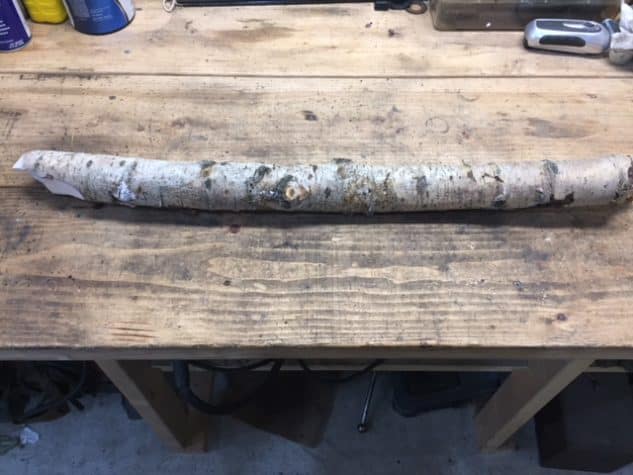
Rustic Feeder Tools and Materials Needed
How To Build A Rustic Suet Log Feeder
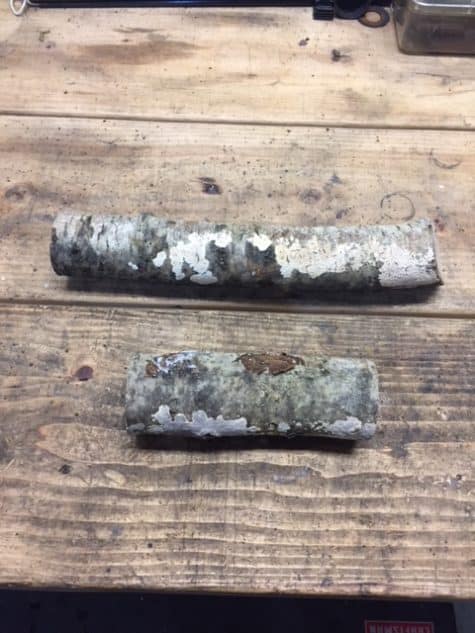
Begin by cutting the three-inch diameter piece of wood into two separate pieces measuring 14″ and 8″ long. One end of the 14″ piece should be cut at a little angle for the top. The kind of wood you use is really your preference. I’ve seen birch, poplar, and cedar used.
Use your hatchet or machete to split the 8″ piece of wood in half. Simply set the hatchet or machete on the centerline of the wood and gently tap it with a hammer. The grain of the above-mentioned wood types is very straight and an 8″ piece should split very easily and straight.
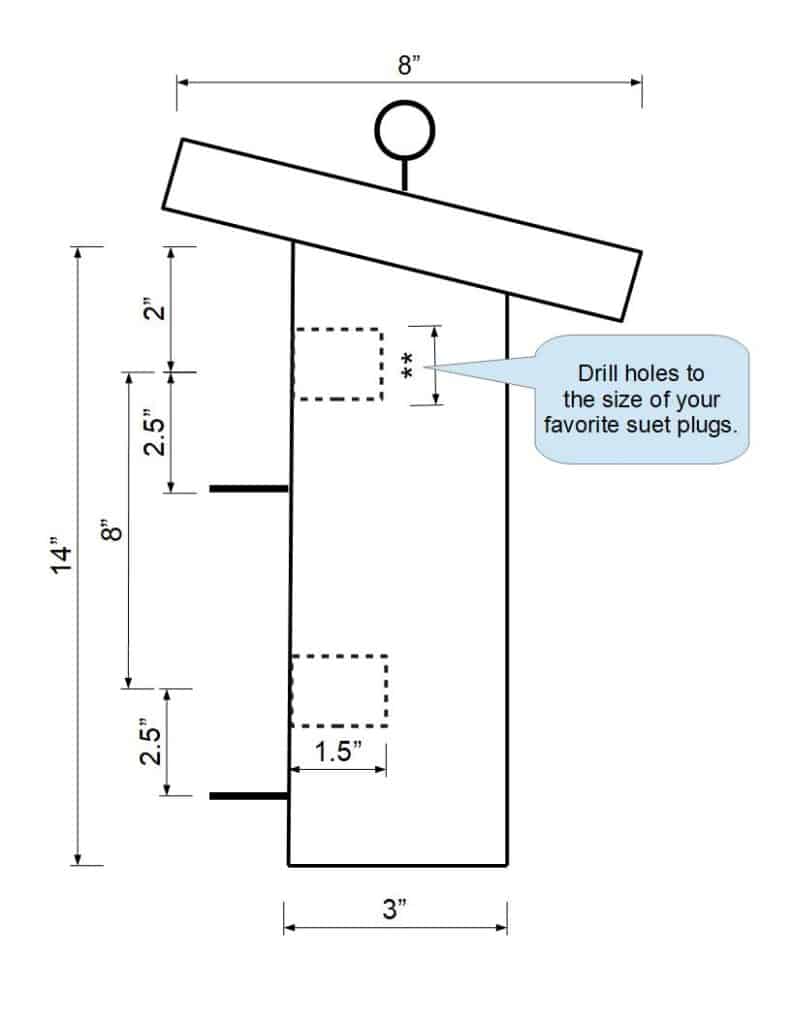
Using the dimensions from the bird feeder plans above (free downloadable copy below), mark where the holes are to be drilled. The angled end of the 14″ piece is the top and the high point is the side where the holes will go. Before drilling the holes you may want to check out my article on Tip For Drilling Holes. An auger bit or paddle bit will work best for this application.
I only drilled two holes in our feeder, but you can drill as many as you would like. Holes can be drilled on the back and the sides as well. It’s totally up to you.
After the suet holes are drilled you can drill the 1/4″ perch holes. This is another optional step. Most birds, such as chickadees, flickers, and woodpeckers, can easily cling to the side of the log body of the feeder. The choice is yours.
Next, it’s time to attach the top. Use the 1/8″ drill bit to drill two pilot holes in the top piece about 3/4″ apart. Attach the top piece with the two drywall screws. Well… I hate to say it again, but this too is optional. You can leave the top piece off and skip right to the next step. This feeder is highly customizable to your liking.
Now drill a third 1/8″ pilot hole between the two screws and insert the steel screw hook. I recommended using the 2″ hook so its long enough to thread into the main body of the feeder, not just the top. As you can see from the picture above it’s possible to attract some pretty good-sized birds.
With the top secured, all that’s left to do is insert the two 1/4″ dowels in for the perches. If needed, apply a small amount of wood glue to hold the dowels in place.
Completed Rustic Suet Log Bird Feeder
That’s all there is to it! Once you have all the material collected, this feeder can be put together in a half-hour. It’s an easy little project and you’ll enjoy feeding and watching the birds all winter long.
Free Rustic Suet Log Bird Feeder Plans
In less than an hour, you can completely build this natural-looking, suet log bird feeder. Here is a link to a set of free plans for this rustic suet log feeder. It’s a PDF file you can print, or save, and share with your family and friends. The dimensions don’t have to be exact and you can scale them up or down in size to suit your needs. Just put some suet in it and hang it up where you can watch the birds enjoy it.
4×4 Suet Log Bird Feeder
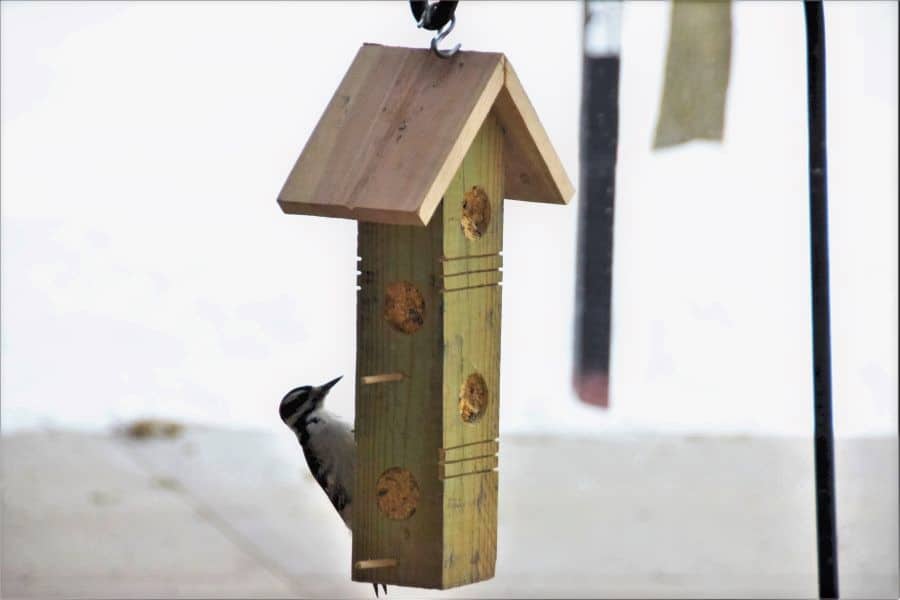
Here is the second version of the suet log bird feeder we have to offer. It can be made from a few pieces of scrap wood you may already have laying around the garage. It has a little nice finished look and can be painted to match the exterior of your home if desired.
4×4 Suet Log Feeder Tools and Materials Needed
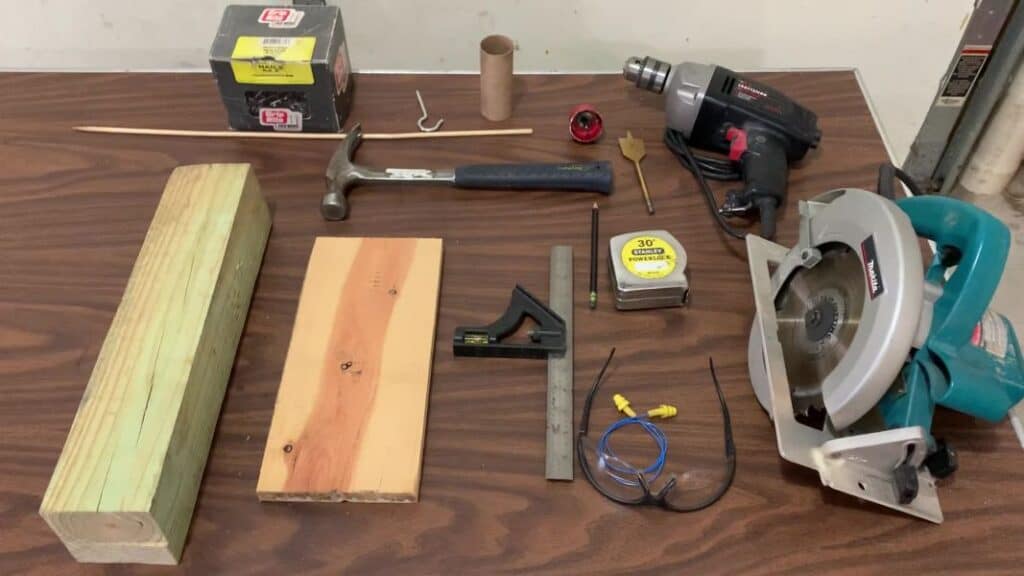
All you need for this project is a small piece of 4×4 wood post, a short piece of 1×6, a few nails, and a screw-in hook. Along with a few handtools from our homeowner’s toolkit and basic woodworking tools list, you’ll have everything you’ll need to get started.
I chose to make the cuts on this feeder with my circular saw to demonstrate that you don’t need a miter chop saw and table saw to make one of these feeders. The cuts may not be perfect or as clean, but the results are still nice and it’s easily doable. If you choose to use one of the other saws, that’s great too. I’m sure the finished product will be a little nicer and would make an awesome gift or to sell at a garage sale.
How To Build A 4×4 Suet Log Feeder
Once you’ve gathered all your materials together, it time to get started. But first a little safety reminder. In the picture of the materials above you’ll see that I’ve included a pair of safety glasses and earplugs. When working with any power tools these two items are a must, at a minimum. For more information on how to protect yourself when working on home projects, please consider reading our article on “Wearing Personal Protective Equipment“. It has some great safety tips.
Another important safety tip is to always secure your workpieces in a vise or by clamping them to a work surface. Never hold a workpiece in your hand when cutting or drilling it with a power tool. You’ll notice in many of the pictures below I am using a portable workbench to secure the wood for most of my cuts. I’ve had this workbench for over 20 years and I use it all the time. It’s a great investment to add to your workshop arsenal.
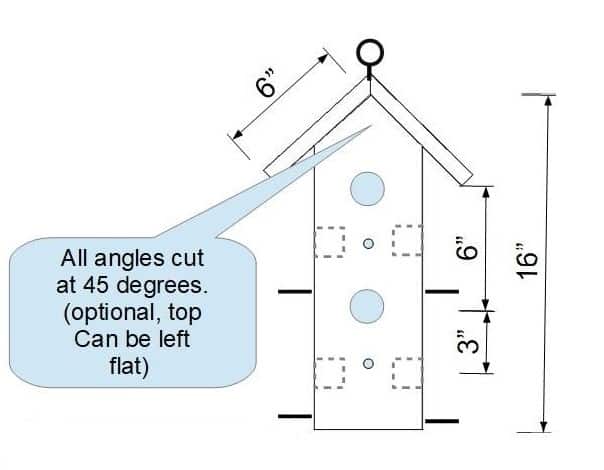
Using the dimensions in the drawing above, (free downloadable full copy below), Start by cutting a 16″ piece of 4×4 post. Which will serve as the main body of the feeder. Next, cut two 1×6 boards to 6″, with one end cut at a 45-degree angle. This will give you a nice mitered peak when finished. As shown above.
Although I made this log feeder with a mitered top, there are a couple of other options for the top you can use (see below). The easiest, fast option is to just leave the top flat and screw the eyelet, or hook, into the top. You won’t need the 1×6 boards and there are no angles to cut. It’s a real timesaver and it works well.
The second option is to use a non-mitered joint on the top. It’s a little simpler to make and there’s no need to change the blade angle on your circular saw to make the cut. It’s a good compromise between the mitered top and the flat top. Just cut one of the top 1×6 boards to 5-1/4″ for a uniform look.
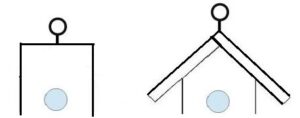
As mentioned above, I cut 45-degree angles on the top of the 4×4 and on the end of the 1×6 boards. Most circular saws, or table saws, are not able to cut all the way through a 4×4. You’ll need to make a cut on one side and then flip the 4×4 over to cut the rest of the way through. When the pieces are all fit together you get a nice finished look. None of this is difficult to do, it just takes a little more time.
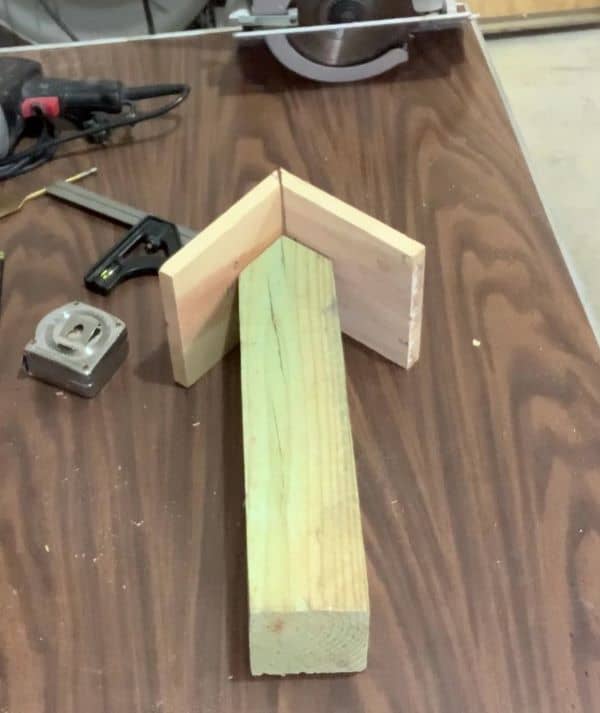
Before attaching the top, it’s best to drill all the suet holes in the 4×4 body. It’s easier to secure in a vise or a work surface. As with the rustic log feeder above, the suet plug holes can be drilled to accept your favorite brand of suet plugs.
I make my own suet plugs, which I touch on a little more below, and I use old paper towel rolls for forms. They are almost 1-3/4″ in diameter, which is a fairly large hole. If you have a 1-3/4″ Forstner, you’re all set. However, they are more expensive and can only be used on wood.
As covered in our article on drilling holes, mentioned above, the average homeowner typically looks for something a little more universal and less expensive. I recommend and use, in place of the more expensive Forstner bits, an arbor hole saw set (which can be used on light metal) and a spade bit set.
The hole saw cuts a nice exterior hole, the only issue is that it does not remove the material in the center. For that, you follow up with a spade bit just big enough to remove the wood in the center. Even if the spade bit is a little too small to get it all, most of the time the thin piece left will break off. If it doesn’t, you can use a screwdriver to easily break it out.
With the suet holes drilled, next you’ll want to drill the 1/4″ holes for the perches. Again, this is easier before attaching the roof boards. I place the perches 1-1/2″ below the bottom of the suet holes. This works well for a variety of bird species.
If you don’t have, or do not want to use, the 1/4″ perches, there is another option. You can cut 3 or 4 shallow grooves, starting at about 3/4″ under the suet holes, about 1/2″ inch apart. My experience with the two types of perches is that woodpeckers use the grooved perches over the dowel perches. Smaller bird species, like chickadees, tend to use the perch more frequently. Although they are easily capable and willing, to use the grooved perches as well.
Before gluing the 1/4″ perch dowels in, now is the perfect time to attach the roof boards. I like to dry-fit the roof into place and then drill pilot holes. The pilot holes help prevent the boards from cracking and also help keep everything lined up for nailing the roof.

Drilling Nail Pilot Holes 
Nailing Roof On
Completed 4×4 Suet Log Bird Feeder
Once the roof is attached all that’s left is to glue the 1/4″ perches in and install the hook in the top. When I install the hook I like to drill pilot and clearance holes. Again, our article on drilling holes mentioned above covers this in more detail.
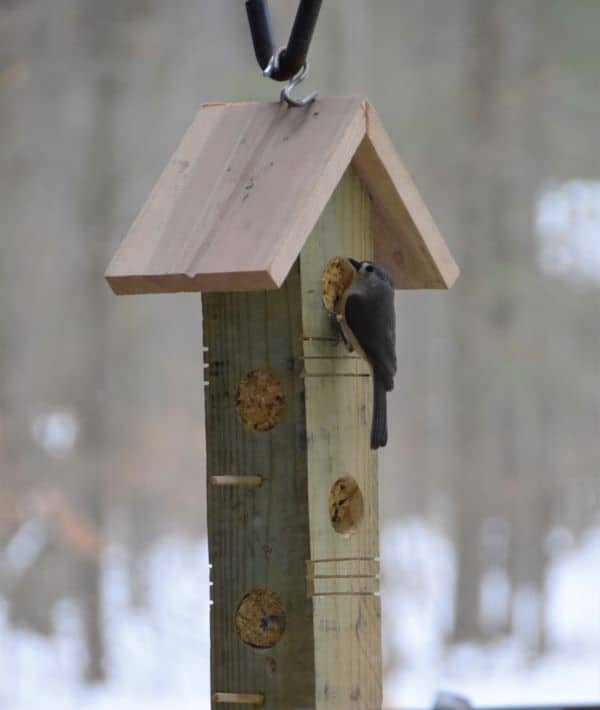
Now just fill it with suet and let the birds enjoy. It won’t take them long to find it.
Free 4×4 Suet Log Feeder Plans
You can completely build this more contemporary-looking, suet log bird feeder In less than an hour. Just click on this link to a set of free plans for our 4×4 suet log feeder. It’s a PDF file you can print, or save, and share with your family and friends. Scale it up or down in size to suit your needs. Just put some suet in it and hang it up where you can watch the birds enjoy it.
Homemade Suet Plug Recipe

The one downside of suet log feeders is that the suet plugs cost about twice as much as the suet cakes. The good news is there are easy, inexpensive recipes to make your own suet plugs. Here is our homemade suet recipe and the birds love it. We also provide a couple of other tips for saving on suet costs. So, build one of these suet feeders and give our suet recipe a try. It will attract many different species of birds and they love it.
Books For The Bird Watcher
Once the birds start coming to your feeder it’s always fun to try and identify the different species. Amazon has a nice selection of bird books to choose from for the bird lover. One of their best sellers is “National Geographic Field Guide to the Birds of North America“. It’s one of the most complete guides for North American birds available.
For something a little less all-encompassing, National Geographic also has it’s “Backyard Guide to the Birds of North America“. It covers 150 of the most common species of bird you’re likely to encounter.
If you’re looking for a book that features something a little on the lighter side, you may want to try the “The Field Guide to Dumb Birds of North America“. This would be a great gift for the bird watcher with a sense of humor! It comes in a Kindle version as well. Be sure to check out Amazon’s collection of bird books.
Conclusion
Feeding the birds is a great way to help them make it through the long winter months. It also provides us humans with a much-needed way to help occupy some of our time during those bitter cold winter days as well. The birds never stop their relentless pursuit of searching for food and now you can help them. Feeding and watching the birds truly is a great pastime for everyone.
If you have any comments or questions, you can leave them in the comments section below or you can email us at [email protected]. FYI, we do not collect or share email addresses. We will only use them to reply to your comments or provide answers to your questions. We are also required to let you know that some of our links are “affiliate links”. This means if you click on a link and make a purchase, we could make a small commission, at no extra cost to you. This helps offset the cost of maintaining our website. So, if you like what you’ve seen, please be sure to give us a “Like” and “Share” on Facebook and Instagram too. Thank you for reading and good luck with all your home projects!


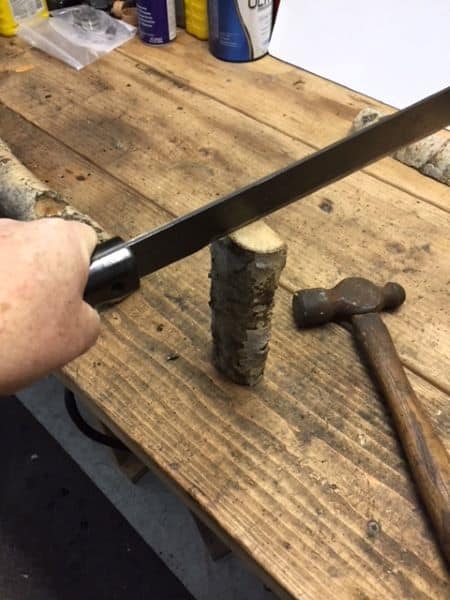
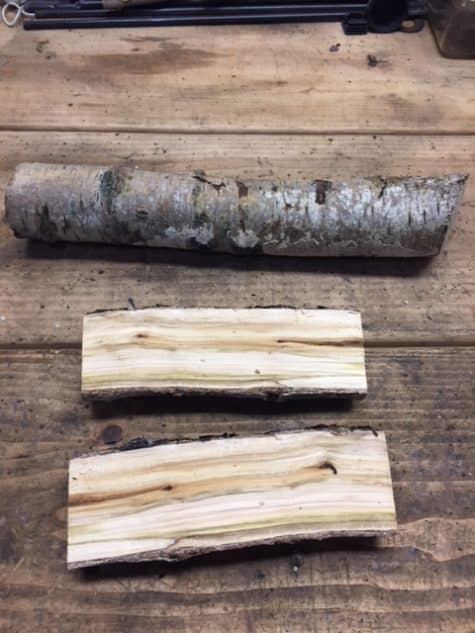
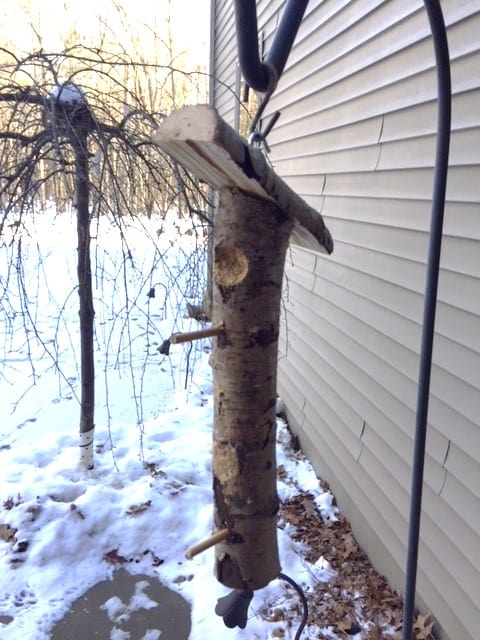
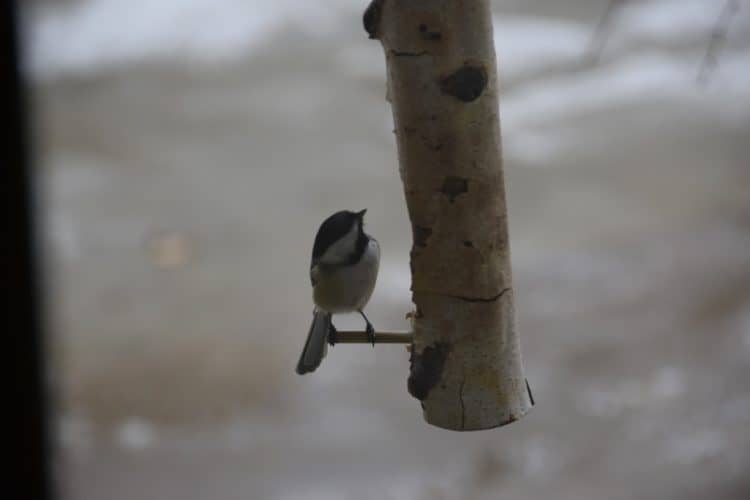
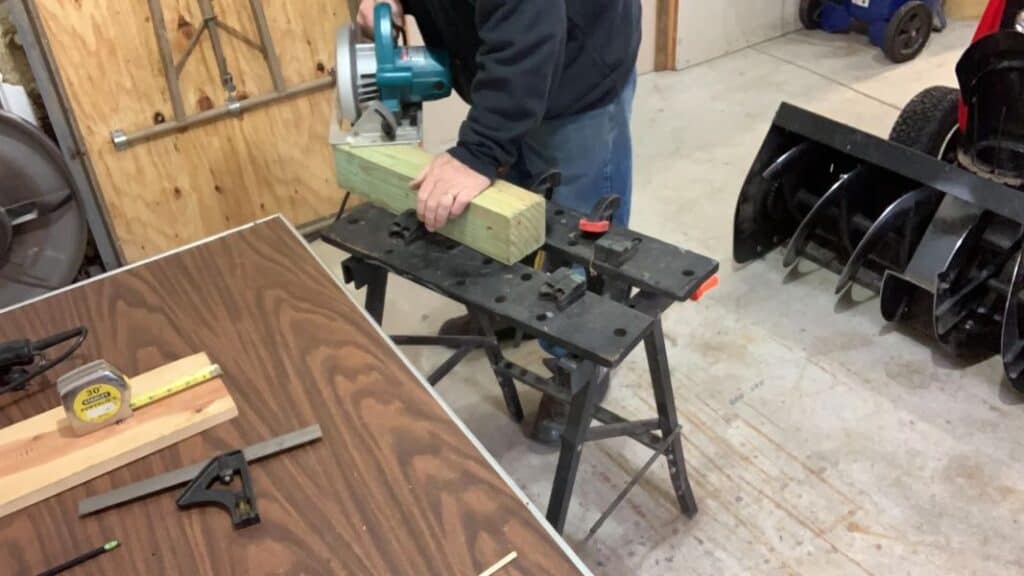











Thank you!
Great blog! I am loving it!! Will come back again. I am bookmarking your feeds also
Thank you!
Good article. I definitely love this website. Continue the good work!
Good points! Thanks for sharing.
I would recommend not using drywall screws as they will rust. Also, make sure your 4×4 isn’t treated.
Love this! I appreciate your time! I need to save this for future use! Thank you!